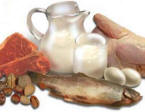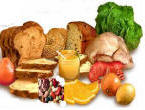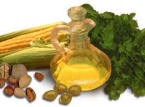Beta-Carotene
Jump to:- What
is Beta-Carotene? |
When was Beta-Carotene discovered |
What does Beta-Carotene do? | Good food
sources of Beta-Carotene
  
Go to:-
5-A-day
Vegetables |
5-A-day Fruit
|
Food and Health Main Page
Calories |
Carbohydrates |
Dietary Fibre
| Minerals
|
Nutritional Requirements
|
Vitamins
Beta-carotene is
a molecule which is part
of the carotenoid family of chemicals found in many fruit
and vegetables, as well as some animal products such as egg yolks.
Beta-carotene was discovered in 1831 by professor Heinrich Wilhelm Ferdinand Wackenroder
who was the first person to isolate the natural orange-yellow pigment in carrots
and who named the term 'carotene' however it wasn't until 1919 that Harry
Steenbock (1886-1967) suggested that there could be
a relationship between beta-carotene and vitamin A.
Beta-carotene is also known as provitamin A, because it is one of the most
important precursors of vitamin A in the human diet, that is to say its molecules
are converted into vitamin A by the body.
The breakdown of beta-carotene occurs in the walls of the small intestine. The
resulting retinol is stored in the liver. If
you eat more beta-carotene than the body needs, less of it is converted, and the rest is stored,
however too much beta-carotene can make you turn yellow.
Beta-Carotene also has antioxidant properties which may help in preventing
cancer and other diseases.
Beta-carotene can be found in a variety of foods including yellow fruit
and vegetables such as sweet potatoes, carrots, sweetcorn, squash, swede
(rutabaga) and melons and in some green vegetables such as kale, spinach
and broccoli.
Back to Top
|